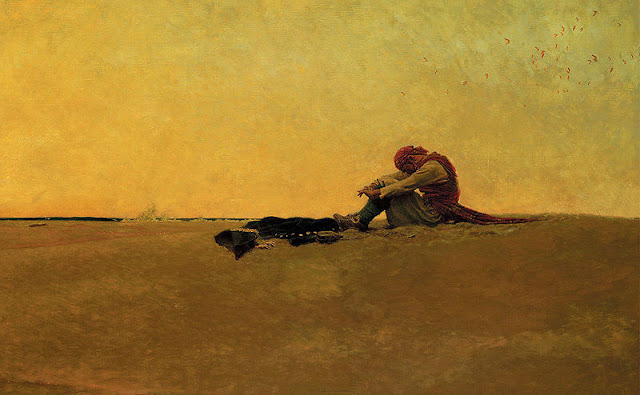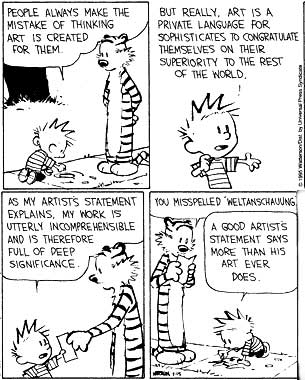Written
while sitting alone, in a borrowed house, staring at art while
waiting to be settled.
We've all heard it
before. Art helps you see the world in wondrous ways, enriching your
life beyond measure. Of course, that's if you "get" art.
I'm no connoisseur, but I know what I like and don't like. I've never
been a fan of recent (much after 1920) art. I always find it too
abstract, too cliquish, too snobby. As if the artist is sending
messages only to other artists or their sycophants.
I prefer my art to
be much more immediate and recognizable. Consequently, I tend to
wander through galleries quickly looking for something understandably
dramatic, beautiful, or whimsical. It only takes a moment to know if
something connects with me or not. It's a rare piece that can do
that, but I've been fortunate to find a few.
One of my favorite paintings is
Marooned by Howard Pyle.
 |
| Is he crying, praying, or pondering? |
I
remember when I first saw it, hanging in its home at the Delaware
Museum of Art. As I strolled through the gallery I remember having to
turn a corner before I came upon the Pyle pile. As I turned, my eyes
were drawn upward. Centered high above my head, but so large that it
dominated its companions, was Marooned. It
didn't move me. Not physically anyway.
Instead
it held me, suspended in its orbit. My heart was beating, my breathe
was shallow, and I was speechless. That last is a trite phrase in the
art world, but it was true this time. I couldn't say anything. It was
as if I was strangled by its screaming loneliness. I felt like a
toddler who could only point at what he wanted.
Fortunately, the
gift shop carried the painting in poster size and I took mine home,
framed it, and hung it in my living room. People would comment that
it was a depressing piece and ask why would I hang it so prominently
in my home. But I loved it. I used to say it was me, or at least it
was how I felt much of the time. This of course didn't add to my
friends' comfort with it. Only one person thought it wasn't a grim
piece, but she was crazy (I didn't know that at the time, but her
reaction should have been a clue).
When
I went off to grad school I took it with me. Having it up made my
temporary apartment feel more like my home. One of my classmates, who
had become a close friend during the semester, commented several
times on how much she liked it. I told her the story of when I first
saw it and we talked about how it seemed to fit our individual
experiences. When I packed up to go home for the my distance-learning
semesters, I gave it to her. It seemed only right to share.
It
was another three years before I made it back to the Delaware and got
a new print. It took another three years before I unrolled it, framed
it, and hung it up again.
At the
same time I rehung Marooned,
I unearthed another painting that also arrested me, El Jaleo, by John Singer Sargent.
 |
| I wonder if the empty chair is for me. |
El Jaleo is
the opposite of Marooned. It's
full of people, music, and motion. I first saw it when my grad school
class visited the Gardner Museum in Boston. It's huge, taking up an entire
wall, which makes the figures seem almost life-size. As we stopped to
look, my classmates commented on the colors, the composition, the
scale. I hardly noticed what they were saying. I love flamenco and
this was the first time something mute had so wonderfully expressed
it. When they noticed me staring in rapture and smiling at the
painting, they asked what I thought. "What a great party!"
I said, stopping myself from playing air guitar in time with the
painting. Naturally I came home with the print, which was only poster
size but better than nothing (besides what wall could I hang even a
half-size print on?).
Unlike Marooned
no one commented on El Jaleo. It garnered neither censure nor
praise. Most people just passed over it. Perhaps they figured it was
part of my fascination with flamenco. Perhaps they didn't see it at
all.
Despite their
differences, I have always hung both of them in the same room, sometimes together on a wall, sometimes across from each other. It never
occurred to me until just now why I did that. No matter where they
are, they are the visual bookends of my life: the silent loneliness
and the raucous party, my need for solitude and my desire to be
expressive. These paintings speak (sing, in one case) to me in ways
precious few others have and I get it. Perhaps best of all, I don't
need an art history degree or a critic's eye to appreciate that.
